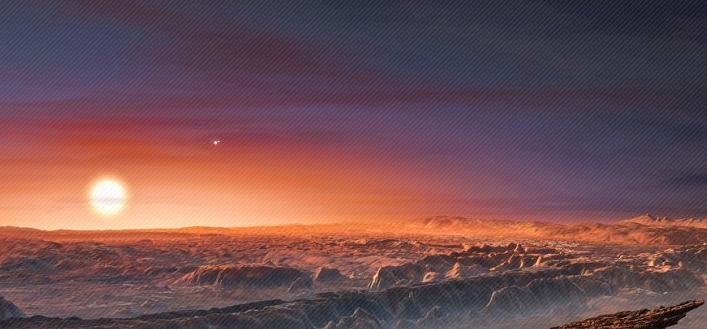
Sky scouring scientists have just announced the discovery of an Earth-like exoplanet in orbit around our own sun’s nearest stellar neighbour, Proxima Centauri. And, not only is this newly noticed world located on our galactic doorstep, it’s also positioned in the right proximity to its host star to make liquid water a possibility…so it could support life.
Astronomers at the European Southern Observatory (ESO) in Chile spotted the planet, presently named Proxima b, using a spectrograph—an ultra-precise instrument called HARPS—attached to a 3.6-metre telescope, which detected a tiny wobble in the star, caused by the orbiting planet.
The revelation, published in the journal Nature yesterday, has sent some scientists into a very excited spin. ‘I think it’s the most important exoplanet discovery there will ever be,’ Dr Carole Haswell from the Open University enthused to BBC news. ‘How can you ever trump something that could be habitable orbiting around the very closest star to the Sun?’
Life on Proxima b would be pretty interesting. The ‘Pale Red Dot‘ team say their discovery is a rocky planet, with around 1.3 times the mass of Earth. They believe it is tidally locked to Proxima Centauri, like our Moon is to Earth, meaning it would have a permanent dark side, where it’s always night, and a light side with a perpetual day.
If it turns out that the planet’s temperature relies on the star alone, the research suggests that its surface would be, on average, a frosty -40˚C. ‘It seems cold, but then if you look at the same numbers for Earth you would get -20, minus -30C,” Dr Anglada-Escudé, the Queen Mary University of London researcher who headed up the Pale Red Dot team, explained to The Guardian. ‘What keeps Earth warm is basically that it has an atmosphere and an ocean.’
Proxima b also operates in an orbit so tight to its host star that its years last only 11 Earth days. Because Proxima Centauri is a Red Dwarf (a star that’s dimmer and cooler than our Sun), however, that still places the planet in the habitable zone—close enough to a star for water to remain liquid, as opposed to ice or gas.
Before you get too excited, it’s worth remembering that, while Proxima might be close to us in relative terms, it’s still some 40 trillion kilometres away (4.2 light years), a distance that would take us millennia to travel using current technology. Conceptual space travel is a fast moving science, though, and earlier this year billionaire venture capitalist Yuri Milner teamed up with astrophysicist Steven Hawking and announced he was investing $100 million into the development of tiny spacecraft that will be laser-propelled across the galaxy, shortening the travel time to Proxima to just decades.
‘For sure, to go there right now is science fiction, but people are thinking about it and it’s no longer just an academic exercise to imagine we could send a probe there one day,’ said Anglada-Escudé.
Further studies will now focus on establishing whether the temperature on Proxima b is conducive for life to exist, which will depend on the presence of an atmosphere. Astronomers, using the European Extremely Large Telescope now under construction in Chile, will attempt to observe the planet as it transits across the face of the star, potentially revealing whether there is a layer of greenhouse gases that are a prerequisite for life as we know it. Red dwarf stars are prone to spitting out solar flares, which would probably play havoc with any atmosphere that does exist.
‘The good news is that it is so close,’ study co-author Ansgar Reiners told CNN. ‘It’s a dream come true for astronomers if we think about follow-up observation.’
[geoip-content not_country=”CA”]
ON THE APP
 Cosmic Journeys: The Search for Habitable Planets
Cosmic Journeys: The Search for Habitable Planets
There are almost 3 trillion planets in our galaxy, however almost none of them are viable candidates for supporting human life. But with the aide of the newly launched planet-hunting Kepler Space Telescope, we may one day find our “Second Earth”.
Want to watch Cosmic Journeys: The Search for Habitable Planets for free right now? Subscribe to the Love Nature streaming app and start your 30-day free trial of the best on-demand natural history documentaries out there. [/geoip-content]

 Cosmic Journeys: The Search for Habitable Planets
Cosmic Journeys: The Search for Habitable Planets